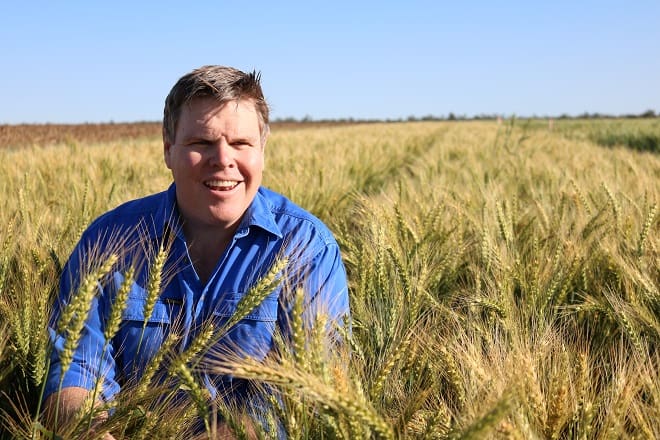
QDAF senior research agronomist Darren Aisthorpe
PRODUCTIVITY gains of up to $400 per hectare in Queensland winter cereal crops are possible if growers can successfully target an optimum flowering window.
Recently completed wheat phenology research has found a staggering difference in yield potential between crops that flowered at optimum and non-optimum times.
Central Queensland trial coordinator, Department of Agriculture and Fisheries (DAF) senior research agronomist Darren Aisthorpe, said growers could reap a significant yield benefit by identifying the ideal target flowering window for a region and adapting sowing date for particular varieties accordingly.
“Trial data showed that when crops flowered in the optimal window, yields were typically 20-30 per cent higher than the average yields across all four sowing dates,” he said.
“In practical terms, if growers can identify when their wheat is likely to flower for a given sowing date and then line that up with the relevant optimal flowering period identified in the trial work, there are some significant yield gains to be made.
“The trial work certainly put this into perspective – based on a wheat price of $250 per tonne, the results showed a $400 per hectare difference in gross margin between crops planted at an optimal and non-optimal time.”
Three-year project
The research project was conducted between 2017 and 2019 as part of a bilateral agreement under the Grains Agronomy and Pathology Partnership between the GRDC and New South Wales Department of Primary Industries (NSW DPI) in conjunction with DAF.
The trials involved planting 32 wheat varieties concurrently across eight different regional locations from central Queensland to southern NSW on the same date four times a year – early and late April and early and late May.
A comprehensive set of data has been collected from these trials in a bid to better understand how different varieties respond in terms of biomass and yield across a range of environments on the different sowing dates.
The resulting analysis is starting to draw important observations about how to optimise key agronomic levers to improve production in specific regions.
Varietal differences
According to Mr Aisthorpe, one of the greatest differences observed across the sites was the variation in varietal response, particularly with regard to days to flowering.
“A quicker spring wheat variety in Emerald, particularly planted a bit earlier, can go to flowering as quickly as 60 days whereas the same variety planted in central NSW can push out to over 100 days,” Mr Aisthorpe said.
“Understanding this difference is crucial in terms of identifying time periods when the plant is most sensitive and prone to stress, and then avoiding those periods so that crop yield potential is maximised for the amount of water available.”
Mr Aisthorpe said growers tended to have a good understanding of the flowering date for specific varieties used on their farms and believes the phenology research can help guide their decisions on sowing date and suitable alternative varieties.
“If their preferred variety flowers in mid-August, but the optimum flowering period for that variety is early August, they could either adjust their sowing date or consider planting a different variety that better suits their planting date.”
Climate website and app
The CliMate website and app https://climateapp.net.au/ can provide valuable assistance to growers in seasonal decision making, enabling users to quickly interrogate the past 65 years of weather statistics, forecasts and climate probabilities for their specific location.
This allows growers to determine where the current season sits historically by tracking current season rainfall, temperature or heat sums for any specified period and explore a range of ‘what if’ scenarios.
“The `how hot/cold’ tool in CliMate is an excellent tool to help growers identify the temperature at which they are going to start seeing stress effects in their crop – typically you don’t want wheat flowering above 30 degrees Celsius or below two degrees Celsius,” Mr Aisthorpe said.
“CliMate data spans a large number of locations so growers can select one that has similar conditions to their farm and use the information as a starting point to identify optimum flowering dates for their crops.”
Weigh up risk
Findings from the trial work may challenge some growers’ existing paradigms on optimal flowering times, particularly if they have previously experienced losses due to frost.
While the work has identified regionally-specific `sweet spot’ flowering periods where yield is maximised, Mr Aisthorpe said growers needed to weigh up the risks of frost and heat stress when planning varietal selection and sowing date.
“While frost is certainly a risk and can have serious implications for Central Queensland crops, so too is heat stress,” he said.
“The trial work showed that yields really began to drop away as evaporative pressure increased and relative humidity decreased. Basically it is a balance of risk versus reward when it comes to sowing date.
“Obviously there’s a wide range of factors driving varietal performance including the major ones – water and nutrition.
“That said, the more comprehensive our understanding is about how different genotypes function under certain sets of conditions, the better off our industry will be simply because significant gains can be made simply by ensuring crops flower when yield potential is maximised for the water available.”
Source: GRDC
For more information, download a copy of the GRDC Update paper Yield stability across sowing dates – how to pick a winner in variable seasons https://grdc.com.au/resources-and-publications/grdc-update-papers/tab-content/grdc-update-papers/2020/02/yield-stability-across-sowing-dates-how-to-pick-a-winner-in-variable-seasons
Mr Aisthorpe discussed some of the key findings in a recently released Grains Research and Development Corporation (GRDC) podcast https://grdc.com.au/news-and-media/podcasts.
Grain Central: Get our free daily cropping news straight to your inbox – Click here

HAVE YOUR SAY